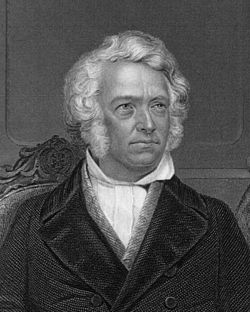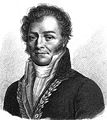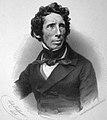Leopold Gmelin
Aspekto
| Leopold Gmelin | |||||
|---|---|---|---|---|---|
 Germana kemiisto kaj profesoro
en la Universitato de Hajdelbergo | |||||
| Persona informo | |||||
| Leopold Gmelin | |||||
| Naskiĝo | 2-a de aŭgusto 1788 en Göttingen, Hanovro, | ||||
| Morto | 13-a de aprilo 1853 en Heidelberg, | ||||
| Tombo | Bergfriedhof (en) | ||||
| Lingvoj | germana vd | ||||
| Ŝtataneco | Reĝlando Hanovro | ||||
| Alma mater | Universitato de Hajdelbergo | ||||
| Familio | |||||
| Patro | Johann Friedrich Gmelin | ||||
| Profesio | |||||
| Okupo | kemiisto universitata instruisto | ||||
| Laborkampo | Kemio | ||||
| Aktiva en | Heidelberg vd | ||||
| Doktoreca konsilisto | Friedrich Stromeyer • Joseph Franz von Jacquin vd | ||||
| |||||
| vd | Fonto: Vikidatumoj | ||||
Leopold GMELIN (1788-1853) estis germana kemiisto, mineralogo, kuracisto kaj profesoro de la Universitato de Hajdelbergo, kiu malkovris la prussan ruĝon[1] kaj kreis la teston de Gmelin, por detekti la ĉeeston de galo aŭ molekuloj de "bilirubino"[2] en la urino. En 1822 li malkovris la kalian fericianidon.[3]
Selektita verkaro
[redakti | redakti fonton]- Dissertatio inauguralis chemicophysiologica sistens indagationem chemicam pigmenti nigri oculorum taurinorum et vitulinorum adnexis quibusdam in id animadversionibus physiologicis Quam ... die I. aprilis A. MDCCCXII publico eruditorum examini submittit auctor Leopoldus Gmelin, 1812
- Diss. sistens indagationem chemicam pigmenti nigri oculorum taurinorum et vitulinorum. 1812
- Handbuch der Chemie, 1817
- Johann Samuel Traugott Gehler's Physikalisches wörterbunch, Volume 5, Johann Samuel Traugott Gehler, Karl Ludwig Littrow, Heinrich Wilhelm Brandes, Leopold Gmelin, Johann Caspar Horner, Georg Wilhelm Muncke, Christian Heinrich Pfaff, Joseph Johann Littrow - 1829
- Lehrbuch der Chemie: Lehrbuch der unorganischen chemie, Volume 1, 1844
- Handbuch der anorganischen Chemie, Karl Kraut, 1853
- Handbuch der organischen Chemie: Organische Verbindungen ..., Volume 4, Issue 3 - 1870
- Handbuch der anorganischen Chemie: 1.2: Nichmetallische einfache Stoffe und ..., Leopold Medico Gmelin (chimico), Karl Kraut, H. Ritter, 1872
- Actinium und Isotope (MsTh [sub] 2), Erna Brennecke, 1942
- Metallurgie des Eisens, 1964
- Kobalt-organische Verbindungen, Volume 5, 1973
- Handbuch der theoretischen Chemie, Volume 1; Volume 3,1988
- Lead: Organolead compounds, Part 3, Friedo Huber, 1992
- Iron: Organoiron compounds, Adolf Slawisch, 1992
- Gmelin Handbook of Inorganic and Organometallic Chemistry: Organorhenium Compounds, Binuclear Compounds 1, Reinhard Albrecht, Leopold Gmelin, Adolf Slawisch, 1995
- Molybdenum: Organomolybdenum compounds, Part 13, Irene Kersting. 1996
Literaturo
[redakti | redakti fonton]- BBC
- National Library of Australia
- Universitato de Hajdelbergo
- The Periodic Table: A Very Short Introduction, Eric R. Scerri
- Encyclopedia of Library and Information Science: Volume 9 - Fore-Edge ..., Allen Kent, Harold Lancour, Jay E. Daily
- Encyclopedia of the Elements: Technical Data - History - Processing ..., Per Enghag
- Pedagogy and the Practice of Science: Historical and Contemporary Perspectives, David Kaiser
- The Development of Modern Chemistry, Aaron J. Ihde
- Is Arsenic an Aphrodisiac?: The Sociochemistry of an Element, William R. Cullen
- Allgemeine Deutsche Biographie
- Neue Deutsche Biographie
- WhoNamedIt?
- Bibliothèque Nationale de France
- Personensuche
- Virtual International Authority File
- WorldCat Identities
- Neue Deutsche Biographie
Vidu ankaŭ
[redakti | redakti fonton]- Carl Friedrich Kielmeyer (1765-1844)
- Friedrich Tiedemann (1781-1861)
- Christian Gottlob Gmelin (1792-1860)
- Jakob Schlesinger (1792-1855)
- Friedrich Wöhler (1800-1882)
- August Hirsch (1817-1894)
- Theodor von Dusch (1824-1890)
- Kemia elemento
- Listo de kemiistoj
- Listo de kemiaj elementoj laŭ atomnumero
Referencoj
[redakti | redakti fonton]- ↑ La prussa ruĝo estas kemia komponaĵo, karakterizata per forta ruĝa koloro, kies molekula formulo estas K3[Fe(CN)6].
- ↑ Bilirubino estas duonflava substanco, trovita en la galo, kiu restas en la sangoplasmo ĝis ties ekskrecio el la urino.
- ↑ The Development of Modern Chemistry














